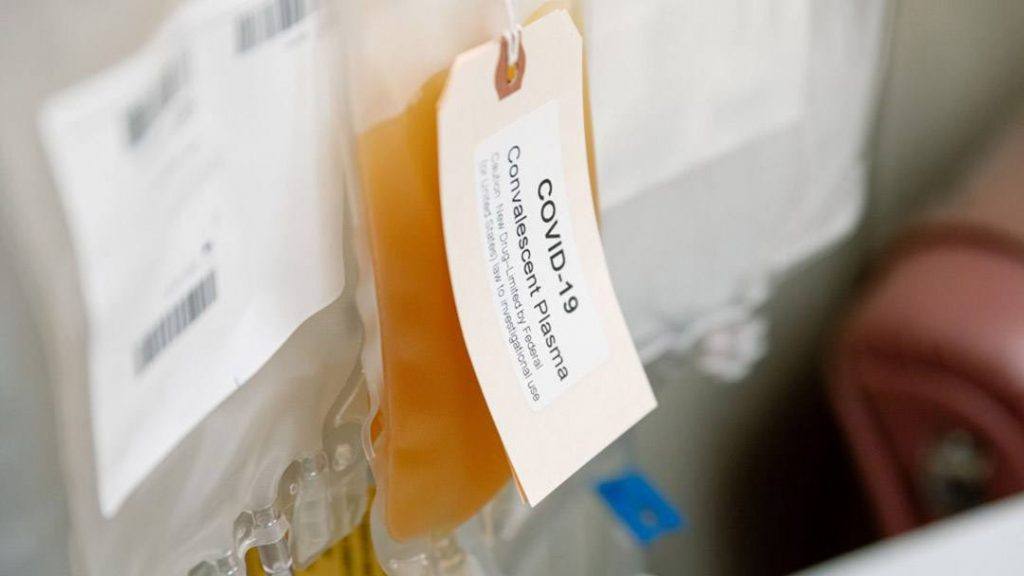
ROCHESTER, Minn. — Mayo Clinic and collaborators have published a preprint that identifies two main signals of efficacy that can inform future clinical trials on plasma therapy on COVID-19 patients. The data are extracted from the Mayo-led national Expanded Access Program (EAP) for convalescent plasma for the treatment of hospitalized patients with COVID-19.
The researchers report in “Effect of Convalescent Plasma on Hospitalized Patients with COVID-19: Initial Three-Month Experience” that the timing of plasma transfusions in a cohort of 35,322 patients were associated with lower mortality. The cohort included a high proportion of critically ill patients, with 52.3% in the intensive care unit (ICU) and 27.5% receiving mechanical ventilation at the time of plasma transfusion. They also report that in a subset of the cohort (3,082 patients), they found lower mortality associated with plasma transfusions that contained higher levels of antibodies against the virus that causes COVID-19. Specifically:
- The seven-day mortality rate was reduced in patients transfused within three days of COVID-19 diagnosis compared with patients transfused four or more days after COVID-19 diagnosis. Similar trends were seen for 30-day mortality rate.
- The use of convalescent plasma with higher antibody levels was associated with reduced seven-day and 30-day mortality.
The overall cohort included a diverse representation of participants by age, gender, weight, race and ethnicity. Study participants included approximately 40% females; 38% Hispanic/Latinos; 19% African American; and 4% Asian. This study includes adult participants enrolled in the U.S. Convalescent Plasma EAP program between April 4 and July 4 who were hospitalized with (or at risk of) severe or life-threatening acute COVID-19 respiratory syndrome.
Watch: Dr. Joyner discusses convalescent plasma.
Journalists: Sound bites with Dr. Michael Joyner are in the downloads at the end of the post. Please courtesy "Michael Joyner, M.D. / Anesthesiology / Mayo Clinic."
Watch: Dr. Wright discusses convalescent plasma.
Journalists: Sound bites with Dr. Scott Wright are in the downloads at the end of the post. Please courtesy "Scott Wright, M.D. / Cardiovascular Disease / Mayo Clinic."
Watch: Dr. Janis Blair discusses convalescent plasma.
Journalists: Sound bites with Dr. Janis Blair are in the downloads at the end of the post. Please courtesy "Janis Blair, M.D. / Infectious Diseases/ Mayo Clinic."
B-roll video of a plasma testing laboratory and a patient donating plasma are also in the downloads. Please courtesy "Mayo Clinic News Network."
It is important to note that the EAP is not and was not intended to be a clinical trial to determine the efficacy of convalescent plasma. It was established by the FDA as a program to increase access to plasma to help severely ill patients at the height of the pandemic and to determine the safety of plasma transfusions. The current observations might indicate factors that may impact effect of treatment and help direct the randomized clinical trials that are needed to establish efficacy. The intent was to offer a procedure that had a history of use at a time when there was no known treatment for this deadly condition.
The researchers point out additional limits to the study:
No data existed as to what dose might be appropriate. Inclusionary criteria were broad; exclusionary minimal. There was no standardized treatment protocol. Enrollment sites were very diverse, from university hospitals to community hospitals. Personnel training was minimal as was the fine detail of data reported.
This project has been funded in part with federal funds from the Biomedical Advanced Research and Development Authority, part of the Office of the Assistant Secretary for Preparedness and Response of the U.S. Department of Health and Human Services, under Contract No. 75A50120C00096. Additionally, this study was supported in part by National Center for Advancing Translational Sciences (NCATS) grant UL1TR002377; National Heart, Lung, and Blood Institute (NHLBI) grant 5R35HL139854; National Institute of Diabetes and Digestive and Kidney Diseases (NIDDK) 5T32DK07352; Natural Sciences and Engineering Research Council of Canada (NSERC) PDF-532926-2019; National Institute of Allergy and Infectious Disease (NIAID) grants R21 AI145356, R21 AI152318 and R21 AI154927; R01 AI152078 9; National Heart Lung and Blood Institute RO1 HL059842; National Institute of Aging (NIA) U54AG044170; Eric and Wendy Schmidt; United Health Group, National Basketball Association (NBA); Millennium Pharmaceuticals, Octapharma USA Inc.; and the Mayo Clinic.
The study’s launch was followed by a national convalescent plasma donation campaign, The Fight Is In Us, supported by the CoVIg-19 Plasma Alliance, American Association of Blood Banks, American Red Cross, Grifols, Bill and Melinda Gates Foundation, Mayo Clinic, Michigan State University, Uber, and many more and promoted by celebrities, including Dwayne “The Rock” Johnson, Helen Mirren, Samuel L. Jackson, Awkwafina, Ken Jeong, Daniel Dae Kim, and Ryan Tedder.
###
About Mayo Clinic
Mayo Clinic is a nonprofit organization committed to innovation in clinical practice, education and research, and providing compassion, expertise and answers to everyone who needs healing. Visit the Mayo Clinic News Network for additional Mayo Clinic news and Mayo Clinic Facts for more information about Mayo.
Media contact:
- Mayo Clinic Public Affairs, 507-284-5005, newsbureau@mayo.edu
Check the Centers for Disease Control and Prevention website for additional updates on COVID-19. For more information and all your COVID-19 coverage, go to the Mayo Clinic News Network and mayoclinic.org.







